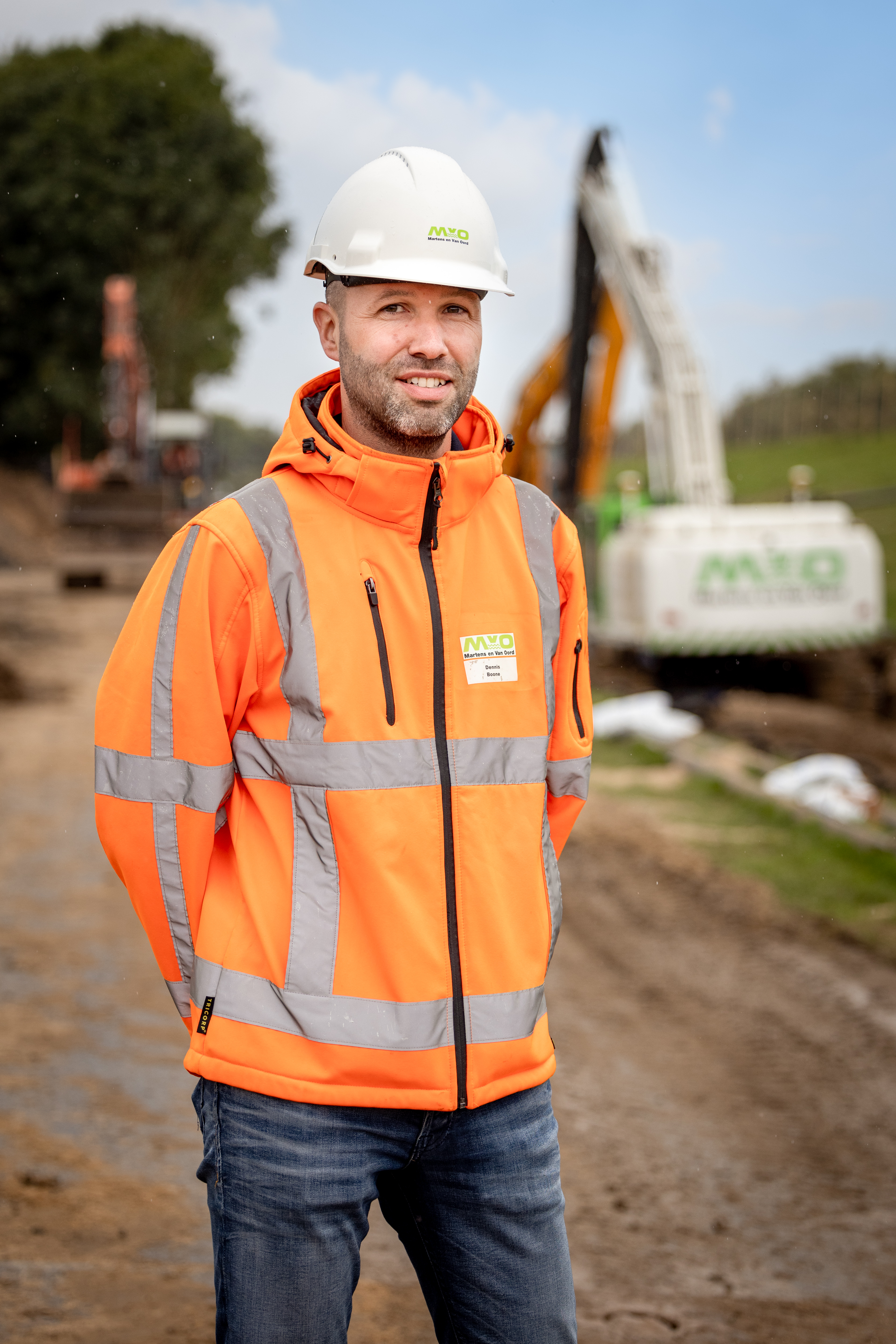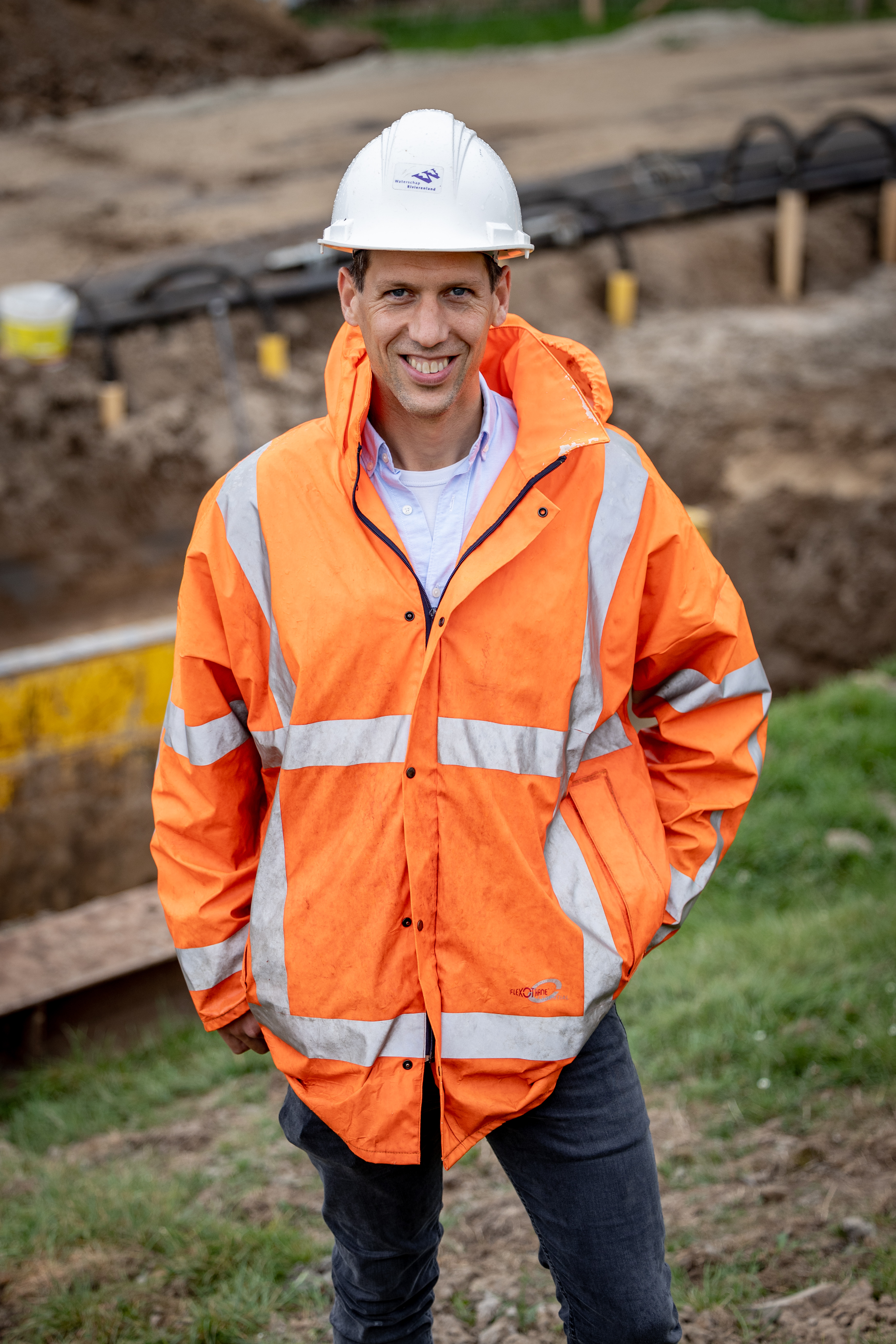The Rivierenland water authority has opted for a new approach to dike strengthening in Gameren: the coarse sand barrier. This technique, which is often more economical and more environmentally friendly than other approaches, prevents the development of backward erosion piping (the formation of channels under a dike towards a river), which can cause dikes to weaken or even fail.
Extreme precision during construction of coarse sand barrier
Late September. On a rainy afternoon, excavators are putting down the coarse sand barrier at the dike in Gameren layer by layer. And it's a striking sight: not one but two contractors are working happily side by side to strengthen the dike. “After a tender procedure involving eleven parties, we finally decided that two contractors would execute the project, each using their own technology,” says Koen van Gerven, the Technical Manager at Rivierenland water authority with responsibility for the design and execution.
Delta Flume
The construction of the coarse sand barrier will take a few months but the idea and preliminary research took much longer. “We started working with this new concept five years ago,” says Deltares project leader Ulrich Förster. “We began in our lab and developed the idea in a large number of trial versions at different scales.” A dike was built to scale in the Delta Flume. Deltares tested how the coarse sand barrier worked and studied the failure mechanism in greater detail in medium-scale trials.
This innovative technique involves introducing a trench of coarse sand at the bottom of the dike where the clay layer and the sandy subsoil meet. The sand acts as a filter, allowing the water to pass through but stopping the fine sand under the dike from being washed away by seeping water. That prevents the formation of hollow spaces below the dike and keeps the dike stable.
Excavators fill the Coarse Sand Barrier for the Gameren dike with sand layer by layer.
The Coarse Sand Barrier is at least 145 cm thick.
The operation to strengthen the Gameren dike involves the introduction of a Coarse Sand Barrier and the construction of a support berm on the inside of the dike locally over a distance of one kilometre. The entire project involves four sub-sections between dike posts 134+50 and 144+50.
The Coarse Sand Barrier is 50 cm above the plane of intersection between the sand and the clay.
Innovation partnership
At the construction site, there is a continuous search for the best solutions in this innovation partnership. Dennis Boone of the Martens and Van Oord - Van der Ven consortium: “Quite a lot of time was invested in looking for the right coarse sand, for example. That involved mixing different grades of coarse sand in the right proportions so that it is permeable enough and also stops the movement of the fine sand under the dike.” Coordination between the parties is important, emphasises Marc van Veggel of the Wetering - FPH Ploegmakers - Vissers Ploegmakers consortium. “This interaction is important. When Deltares tweaked the design, we looked at whether the changes were feasible and made the required operational adjustments.”
The fight against piping
The Flood Risk Management Programme (HWBP) is strengthening 1500 kilometres of dikes in the Netherlands. The dikes that are susceptible to piping are mainly located in the east of the country: the river area between Zaltbommel and Zwolle as far as the German border. The sand layers are close to the surface of the dike here.

Environmentally friendly
Working with a coarse sand barrier is cheaper, faster and more environmentally friendly, and saves more space, than other solutions such as building a wide berm or a steel sheet pile, explains Ulrich Förster. “Sheet piling can disrupt the water regime below the dike and it is more expensive to put in.” Other water authorities have visited us to see how it works. “There is a lot of interest in this approach,” says Koen van Gerwen.
More information

Ulrich Förster
Researcher and dike expert Deltares

Two worlds
“A new thing for us in this project was that we contributed much more actively to the solutions. But that works well. Two worlds meet: the science of Deltares and our practical knowledge. That is how you come up with innovative solutions.”
Dennis Boone,
Martens en Van Oord & Van der Ven

800 kilometres
“There are around 800 kilometres of dikes that have failed inspection procedures because of possible piping. The water authorities can tackle more than half of those dikes using this approach.”
Ulrich Förster, projectleider en onderzoeker Deltares

Step by step
“You are always coming across new challenges but we have been successful by clearly defining each step in the process and contributing knowledge together.”
Koen van Gerven, Waterschap Rivierenland

Interaction
“By combining knowledge and expertise in the Monitoring Think Tank, we got together to establish a monitoring system that the dike manager can use. The locality is closely involved with the project. Local people can get in touch with us to ask questions and we organise weekly excursions for interested parties.”
Marc van Veggel, Wetering - FPH Ploegmakers - Vissers Ploegmakers
